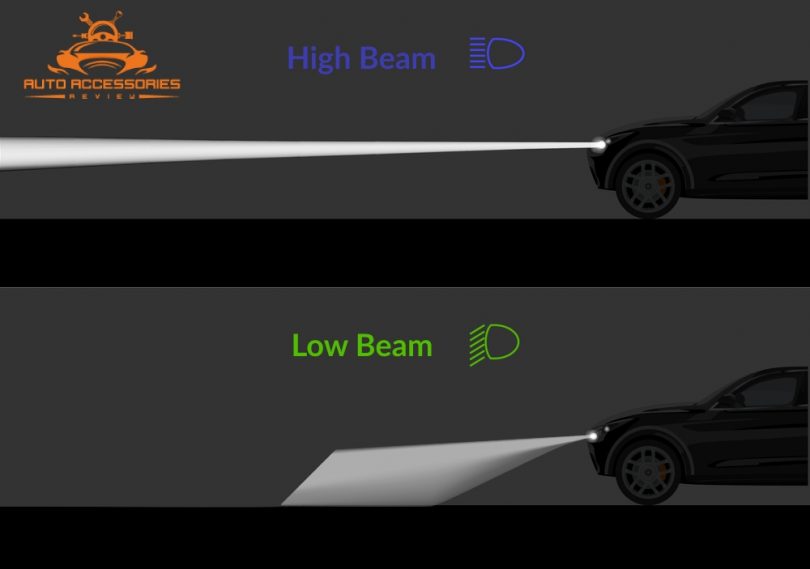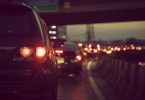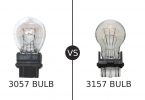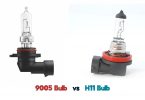While both high beams and low beams are used after dark, they are as different as day and night. When you switch on your headlights, your low beams come on. And when you need more light on a desolate road or stretch of highway without streetlights, you turn on the high beams.
Here we’ll compare all aspects of high and low beams and offer tips for using both.
High Beam vs Low Beam: What You Need to Know

1. Brightness
Low Beam
Low beams are bright enough to light the road closely in front of the vehicle for a short distance. With streetlights and low beams, the driver can see well.
High Beam
High beams are so bright that they can be blinding to oncoming traffic. They illuminate the road in front of the car for a longer distance than the low beams.
2. Light intensity
Low Beam
The maximal output for a low beam is 1380 lumens which are equal to 1380 lit candles at a foot distance from the front of the car (one lumen is the equivalent of one birthday candle at a foot distance.)
High Beam
The high beam output has a max of 1410 lumens.
3. Angle of the beam
Low Beams
Low beams illuminate at a downward angle toward the road.
High Beam
The illumination of the high beam is straight ahead of the vehicle, lighting the road and slightly peripheral.
Winner
There is no winner, they have different functions, and the comparison only leaves room for a tie as they are both great for what they illuminate.
4. Illuminated area
Low Beam
The low beam illuminates an area in front of the car that is 150-200 feet long.
High Beam
The high beam offers an area of illumination 250-300 feet in length.
Winner
If you look at the distance, the high beam illumination is the winner.
5. Where the beam shines
Low Beam
Low beams illuminate the road in front of the car. The light is on the road so that you can see a short distance in front of the vehicle.
High Beam
High beams light up the area in front of the car but not the road. They shine in the distance for a better view of what is ahead.
6. Best Uses
Low Beam
Low beams are your regular driving lights. You use them on the highway or in urban areas with streetlights. The use of low beams is ideal in adverse conditions like rain, fog and snow.
High Beam
You use high beams when you need them on dark roads or a patch of an unlit freeway, or when warning others of a danger ahead.
7. Activation
Low Beam
When it gets dark, the low beams should be in use to brighten areas with dim light.
High Beam
High beams should only be in use when a stretch of road has no light. As you approach another vehicle, the high beams should be off within 490 feet of an oncoming driver. If a driver is in front of you, turn off the high beams.
8. Legal issue
Low Beam
Low beams are legal everywhere you drive.
High Beam
While high beams are legal, their use and flashing to warn other drivers differs in each city, county, and state. When using HID high beams, the laws vary from state to state.
9. Intensity
Low Beam
Low beams offer less intensity than high beams. The light projects approximately 131 feet.
High Beam
High beams offer a maximum intensity to illuminate a larger area. The high beams project approximately 328 feet, more than double the low beams.
10. Power use
Low Beam
Low beams can run on 6V or 12V and use 45-55 watts for each bulb.
High Beam
High beams require 12V to support a bulb at 55 watts thru 65 watts.
11. When are they best used?
Low Beam
Legally low beams must be in use 30 minutes before the sun goes down or visibility is poor such as a storm or snow, and remain on until 30 minutes after the sun comes up. In some states, you must have low beams and running lights on when the windshield wipers are in use.
High Beam
The best use of high beams is unlit remote areas or areas with low visibility. Never use them in rainy, snowy, or foggy conditions, as the lights will reflect off the moisture and obscure your visibility.
High beams often warn other drivers of road hazards such as accidents or road trees. Never use the high beams when approaching traffic within 283 feet or immediately in front of you. Be cautious on curves and mountain roads where you do not immediately see oncoming traffic. Your high beams can be blinding to these drivers with disastrous results.
12. Which can you use regularly?
Low Beam
Low beams are constantly in use between sundown and sunup.
High Beam
Use your High beams for emergency warnings and low to no light areas.
13. Too bright for other drivers
Low Beam
Low beams are less intense and offer an acceptable brightness for other drivers.
High Beam
The intensity of high beams is blinding to oncoming drivers and should turn off as the oncoming car approaches. You may use them to alert others of safety issues as long as it is a quick flash.
Low beam safety tips
- Clean your headlights regularly so you get the low beams full intensity
- Be safe and drive at lower speeds when using low beams due to limited illumination
- As you approach other vehicles, make sure you have on your low beams
- Use only the low beams in fog, rain, and snow
- Adjust low beams so the driver side is slightly lower than the passenger side beam
High beam safety tips
- Once you have passed the area of low or no lights, turn off the high beams
- If the cars around you don’t have high beams, turn yours off
- Never use high beams as you would the low beams
- Check the high beams to ensure they work and maintain them so they will work when you need them most
- When high beams are coming at you, look in the other lane
- Adjust the rear view mirror so high beams from behind you are not blinding
- Anytime your lights are blinding to other drivers, turn them off
- When flashing other drivers a warning, turn the high beams on then off quickly so they are not distracted
FAQs
1. Can the low and high beams use the same bulb size in a single beam bulb?
Ans. Most older cars have four different bulbs, a high and low beam bulb on each side. Newer cars have a dual-filament bulb, so they only need one bulb. This bulb provides low and high beam light lighting from the same bulb.
The dual filament projects low-intensity lighting toward the road in low beam mode and the ability to shine intensely in conditions that require high beam lights. A conical illumination lights the road when both filaments are in use.
2. Should I use high beams in adverse weather conditions?
Ans. Never, the beam reflects off the moisture and creates a wall of reflection towards your car that impairs your visibility. This situation is dangerous to the driver and traffic coming toward you and driving in front or alongside you.
3. Why does one beam go off when the other one is on?
Ans. Sometimes the situation arises when your low beam works, but the high beam doesn’t or you have high beams but no low beams. There are multiple reasons this can happen. They include:
- A broken headlight switch
- A burnt-out headlight bulb
- Loose, damaged, or stripped wires
- A corroded headlight socket
- A blown fuse or damaged relay










Leave a Comment